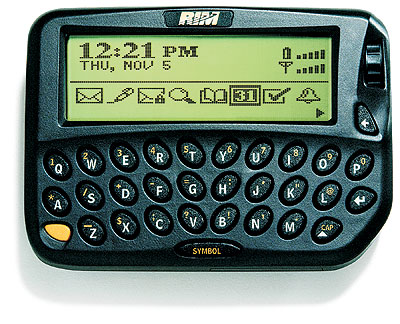BlackBerry Limited (formerly Research In Motion) is a mobile communications company. Founded in 1984 by Mike Lazaridis and Doug Fregin in Waterloo, Ontario, the company released its first device — a pager capable of email — in 1999. Following the release of its first smartphone in 2002, BlackBerrys quickly became must-have pieces of technology, first among business people and later the general public. However, in the early 2010s they struggled to keep pace with the competitive smartphone market. In 2016, the company announced it would outsource all hardware production to other companies, instead focusing on software development. Today, BlackBerry is credited with putting Waterloo on the map as an innovation hub. The business trades under the ticker BB on the Toronto Stock Exchange and BBRY on NASDAQ.

Research In Motion Founded in Waterloo
Research In Motion (RIM) was co-founded in 1984 by University of Waterloo electrical engineering student Mike Lazaridis and Douglas Fregin, a close childhood friend. The company’s humble beginnings started above a bagel shop in Waterloo, Ontario, where at least one employee had to build their own workstation. RIM was first launched as a software and computer science consulting business, but by 1988 they were developing a wireless data transmission system that would be used in pagers and wireless payment — making them the first to work on such technology in North America. This technology would eventually provide a foundation for the BlackBerry smartphone.
RIM’s work caught the eye of Harvard Business School graduate Jim Balsillie. The 31-year-old believed so strongly in the company’s technology that he remortgaged his house and backed the start-up with $125,000. He would join RIM as co-founder and co-CEO after making that investment.
Invention of the BlackBerry

The precursor to the BlackBerry smartphone was the RIM Inter@ctive Pager 900, introduced in 1996. The two-way pager was equipped with a QWERTY keyboard and capable of sending faxes and emails. When it came to naming the new device, branding executives felt its keyboard resembled strawberry seeds, which led to exploring the names of fruits and vegetables. They eventually landed on BlackBerry, as it matched the device’s black casing.
Did you know?
When it came to naming RIM’s new device the RIM Inter@ctive Pager 900, branding executives felt its keyboard resembled strawberry seeds, which led to exploring the names of fruits and vegetables. They eventually landed on BlackBerry, as it matched the device’s black casing.
RIM listed on the Toronto Stock Exchange in 1997 and managed to raise more than C$105 million from the initial public offering. Just two years after going public, RIM introduced its new BlackBerry email service to North America in January 1999, which prompted sales to increase by 80 per cent to US$85 million. The following year’s revenue reached US$221 million. The company’s seemingly overnight success continued as it then went public on NASDAQ in 1999 to raise another US$250 million.
First BlackBerry Smartphone Released

After its launch, BlackBerry began its meteoric rise in the technology community. This was mostly led by co-CEO Jim Balsillie’s enthusiastic travelling roadshow efforts, giving the device out for free at industry conferences and also promoting it to investment bankers on Wall Street.
The 11 September 2001 attack by terrorist organization Al-Qaeda on the United States solidified RIM’s reputation as a solid telecommunications provider, as its network remained intact when other wireless systems broke down (see 9/11 and Canada).
In 2002, the BlackBerry 5810 was released — the first device from RIM able to make calls. Within two years of introducing its cellphone service, RIM reported more than 1 million subscribers and reached 9 million by 2007. The BlackBerry started off as a device for investment bankers and early technology adopters but soon became the smartphone everyone owned or hoped to own.
NTP Patent Lawsuit
RIM’s success caught the attention of Virginia-based NTP Inc. and it sued RIM in 2001 claiming patent infringement. Although NTP doesn’t make any of its own products, it had filed patents on a mobile, wireless email system with the intention of building the technology in the future. NTP ended up winning the case, which resulted in an initial court order settlement of US$23.1 million.
RIM spent a lengthy three-year battle in appeals courts before a settlement was made for a final US$612.5 million in 2006.
The lawsuit dampened growth for RIM as the company reported in 2006 that the number of BlackBerry subscribers fell by 120,000 in that year’s fourth quarter. A spokesperson attributed this to uncertainty surrounding the NTP litigation, which had caused customers in the US to defer any BlackBerry purchases. Revenue in that quarter also suffered, as RIM only managed to hit US$560 million instead of its projected $620 million. Though significant, the company’s finances were stable enough to be able to survive the setback.
As a part of the settlement, RIM was able to continue selling its products and services without having to pay royalties to NTP.
Competition from the iPhone, Google Android
By 2007, RIM had acquired more than 30 per cent of the US smartphone market and was second only to Finnish telecommunications firm Nokia globally. That same year, Apple, a computer company from Silicon Valley, released the iPhone, disrupting the smartphone market and becoming one of the main catalysts of RIM’s decline.
Did you know?
Silicon Valley is the nickname for the southern portion of the San Francisco Bay Area in Northern California where many tech companies operate. Situated mainly in the Santa Clara Valley, the area gets the “silicon” portion of its nickname for the many silicon computer chip manufacturers in the area.
The iPhone was a game changer for the smartphone industry because of its touchscreen, which allowed users to navigate the Internet via Apple’s Safari Web browser. Its launch of the App Store in 2008 also redefined the needs of the early smartphone market by offering a platform for third-party apps.
Initially, RIM leadership did not view competitors such as Apple and Google as threats because sales for the BlackBerry continued to grow — the company reached almost US$20 billion in sales by 2011. That year was the tipping point though, as consumers in North America and the UK, previously RIM’s key markets, were beginning to favour iPhones and Google’s Android phones.
In response to fierce competition, RIM released the BlackBerry Storm in 2008, which eliminated the QWERTY keyboard that made its devices famous in the first place. There was much criticism of RIM’s new touchscreen device, as users complained that they had lost the ease of text entry. Critics also felt that the BlackBerry operating system was inferior to the one that Apple had developed.
RIM responded to users and rolled out a hybrid device called the BlackBerry Torch in 2010, which featured both a touchscreen and QWERTY keyboard. The Torch fared well at the beginning, selling 150,000 devices within the first three days. However, Torch sales were unable to surpass those of the iPhone.
In 2009, RIM also launched its own third-party app store called BlackBerry App World, which came out nearly a year after the App Store and limited users to only a few hundred apps. By comparison, Google launched its own app store (called the Android Market) just three months after Apple’s.
To enhance its software experience, RIM acquired QNX Software Systems from American car technology company Harman International in 2010. While the idea to integrate QNX with BlackBerry’s operating system was strategic, the implementation took too long and RIM had to lay off 2,000 employees before the new software was complete. The layoffs were a part of what the company called a “cost optimization program.” RIM debuted the QNX software on a new line of tablets called the PlayBook, which never managed to achieve strong sales.
Did you know?
In 2011, Canada Post released a series of four stamps commemorating Canadian innovations. The BlackBerry was one of the inventions featured in the series as it revolutionized communication.
The other inventions featured in the stamp series included the cardiac pacemaker, the electric oven and electric wheelchair
Balsillie and Lazaridis Step Down
In January 2012, following the failure of the QNX software and the PlayBook, Jim Balsillie and Mike Lazaridis announced that they were stepping down. At that point, RIM had lost 75 per cent of its market value and Balsillie and Lazaridis reportedly had been grooming Thorsten Heins, who had been an executive with the company since 2007, for the role of CEO.
Balsillie and Lazaridis remained on the board, while Lazaridis took on a new title as vice-chair of the board of directors as well as chair of the innovation committee. On 29 March 2012, Balsillie resigned from the board and sold all his BlackBerry shares the following year; Lazaridis stepped down on 1 May 2013 and sold about 12 per cent of his shares that December.
RIM Rebrands as BlackBerry
With Thorsten Heins as CEO, RIM underwent several big changes, one of which was rebranding the company to BlackBerry in 2013 — the name of its flagship product.
Repositioning the company under a far more recognizable brand name suggested that RIM was hoping for a fresh start. At the same time as the rebranding, RIM released its long-delayed BlackBerry 10 operating system and Z10 and Q10 devices. While the new operating system and the Z10 touchscreen device were deemed vast improvements from past offerings, BlackBerry still faced challenges competing with the likes of Apple and Google. At the time, Android held 52.5 per cent of the smartphone market while Apple held 34.3 per cent.
Despite the new name and products, BlackBerry was unable to reclaim its market share. In November 2013, Heins, after less than two years in the chief executive post, was replaced by Silicon Valley executive John Chen.
Shift to Software and Secure Communications
In 2015, BlackBerry began to release smartphones that ran on a third-party operating system, the first of which was the BlackBerry Priv, which ran on a customized version of Android. This was followed by the DTEK50 the following year. Also in 2015, BlackBerry acquired one of its key competitors, enterprise mobile management company Good Technology, for US$425 million. The company’s focus shifted to the development of device management software, which helps businesses track employee phones to keep sensitive company information secure.
After failed attempts to get the company back on track, in September 2016 BlackBerry announced it would leave the smartphone manufacturing business. While CEO John Chen began outsourcing some production when he was hired in 2013, the development and manufacturing of future devices was entirely in the hands of overseas partners such as manufacturers Foxconn Technology Group and TCL Communications by late 2016.
In July 2017, the National Security Agency (NSA), the United States’ largest intelligence agency, endorsed BlackBerry’s software for encrypting phone calls and text messages. As a result, BlackBerry gained the approval necessary to sell its commercial encryption software, SecuSUITE, to members of the US government.
Also in 2017, BlackBerry launched a new smartphone and advertising campaign. The KEYone, an Android smartphone with a QWERTY keyboard, was unveiled under the slogan “Do More. Different.”
In November 2018, BlackBerry announced it would acquire artificial intelligence and cybersecurity company Cylance. The US$1.4 billion deal signalled a major investment in BlackBerry’s software business. According to news outlet Bloomberg, the acquisition was the company’s largest in seven years.
As of 4 January 2022, BlackBerry decommissioned legacy services for BlackBerry 7.1 OS, BlackBerry 10 software, BlackBerry Playbook OS 2.1, and earlier software. Devices running these older operating systems will no longer be able to reliably make phone calls, send text messages or use data. The decommissioning of these legacy services and software mark BlackBerry’s continued business focus towards software and secure communications.

 Share on Facebook
Share on Facebook Share on X
Share on X Share by Email
Share by Email Share on Google Classroom
Share on Google Classroom





